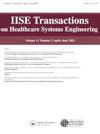Task, usability, and error analyses of ambulance-based telemedicine for stroke care
IF 1.5
Q3 HEALTH CARE SCIENCES & SERVICES
IISE Transactions on Healthcare Systems Engineering
Pub Date : 2021-02-08
DOI:10.1080/24725579.2021.1883775
引用次数: 8
Abstract
Abstract Past research has established that telemedicine improves stroke care through decreased time to treatment and more accurate diagnoses. The goals of this study were to 1) study how clinicians complete stroke assessment using a telemedicine system integrated in ambulances, 2) determine potential errors and usability issues when using the system, and 3) develop recommendations to mitigate these issues. This study investigated use of a telemedicine platform to evaluate a stroke patient in an ambulance with a geographically distributed caregiving team comprised of a paramedic, nurse, and neurologist. It first determined the tasks involved based on 13 observations of a simulated stroke using 39 care providers. Based on these observational studies, a Hierarchical Task Analysis (HTA) was developed, and subsequently, a heuristic evaluation was conducted to determine the usability issues in the interface of the telemedicine system. This was followed by a Systematic Human Error Reduction and Prediction Approach (SHERPA) to determine the possibility of human error while providing care using the telemedicine work system. The results from the HTA included 6 primary subgoals categorizing the 97 tasks to complete the stroke evaluation. The heuristic evaluation found 123 unique violations to heuristics, with an average severity of 2.38. One hundred and thirty-one potential human errors were found with SHERPA, the two most common being miscommunication and selecting an incorrect option. Several recommendations are proposed, including improvement of labeling, consistent formatting, rigid or suggested formatting for data input, automation of task structure and camera movement, and audio/visual improvements to support communication.基于救护车的卒中远程医疗的任务、可用性和错误分析
摘要过去的研究表明,远程医疗通过减少治疗时间和更准确的诊断来改善中风护理。这项研究的目标是:1)研究临床医生如何使用集成在救护车中的远程医疗系统完成中风评估,2)确定使用该系统时的潜在错误和可用性问题,3)制定缓解这些问题的建议。这项研究调查了远程医疗平台在救护车上评估中风患者的使用情况,该平台由一个地理分布的护理团队组成,该团队由一名护理人员、护士和神经学家组成。它首先根据39名护理人员对模拟中风的13次观察结果确定了所涉及的任务。基于这些观察性研究,开发了分层任务分析(HTA),随后进行了启发式评估,以确定远程医疗系统界面中的可用性问题。随后采用了系统人为错误减少和预测方法(SHERPA),以确定在使用远程医疗工作系统提供护理时发生人为错误的可能性。HTA的结果包括6个主要子目标,对完成中风评估的97项任务进行分类。启发式评估发现123种独特的启发式违规行为,平均严重程度为2.38。SHERPA发现了131个潜在的人为错误,其中最常见的两个是沟通失误和选择错误的选项。提出了一些建议,包括改进标签、一致格式、数据输入的刚性或建议格式、任务结构和相机移动的自动化,以及支持通信的音频/视觉改进。
本文章由计算机程序翻译,如有差异,请以英文原文为准。
求助全文
约1分钟内获得全文
求助全文
来源期刊

IISE Transactions on Healthcare Systems Engineering
Social Sciences-Safety Research
CiteScore
3.10
自引率
0.00%
发文量
19
期刊介绍:
IISE Transactions on Healthcare Systems Engineering aims to foster the healthcare systems community by publishing high quality papers that have a strong methodological focus and direct applicability to healthcare systems. Published quarterly, the journal supports research that explores: · Healthcare Operations Management · Medical Decision Making · Socio-Technical Systems Analysis related to healthcare · Quality Engineering · Healthcare Informatics · Healthcare Policy We are looking forward to accepting submissions that document the development and use of industrial and systems engineering tools and techniques including: · Healthcare operations research · Healthcare statistics · Healthcare information systems · Healthcare work measurement · Human factors/ergonomics applied to healthcare systems Research that explores the integration of these tools and techniques with those from other engineering and medical disciplines are also featured. We encourage the submission of clinical notes, or practice notes, to show the impact of contributions that will be published. We also encourage authors to collect an impact statement from their clinical partners to show the impact of research in the clinical practices.
 求助内容:
求助内容: 应助结果提醒方式:
应助结果提醒方式:


